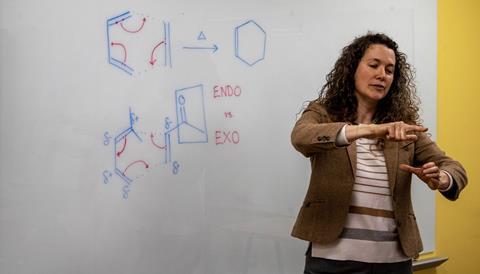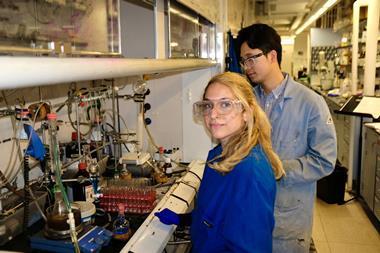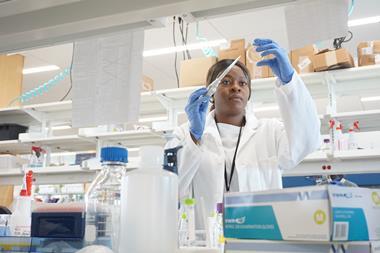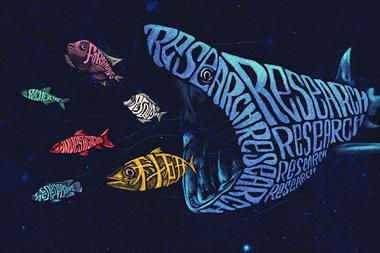Rebecca Trager speaks to a US team developing a sign language lexicon for chemistry concepts that combines form with meaning to make the field more accessible for everyone
- Development of chemistry-specific signs: A team at Rochester Institute of Technology (RIT) developed a sign language lexicon for organic chemistry, creating nearly 300 signs to represent chemical reactions and concepts, making the subject more accessible for Deaf and hard of hearing students.
- Improved academic performance: The introduction of these signs in Christina Goudreau Collison’s chemistry class significantly improved the academic performance of Deaf students, who previously scored 10–20% lower than their hearing peers. After implementing the signs, Deaf students’ scores not only matched but often surpassed those of hearing students.
- Inclusive teaching methods: The use of these signs in Goudreau Collison’s chemistry class has benefited both Deaf and hearing students by providing a 3D, visual representation of chemical reactions, enhancing comprehension and retention of complex concepts.
- Expansion and recognition: The project, known as the sign language incorporation in chemistry education (Slice) team, received the Royal Society of Chemistry’s inclusion and diversity prize in 2022. The initiative is expanding to include signs for general chemistry and biochemistry, supported by funding from the US National Science Foundation.
This summary was generated by AI and checked by a human editor
Until a few years ago, Deaf students and sign language interpreters in Christina Goudreau Collison’s chemistry class at Rochester Institute of Technology (RIT) in the US would fingerspell terms like SN2 for a bimolecular nucleophilic substitution reaction. Now, they move their hands in a fluid movement to indicate how starting materials transform via a transition state into the final product.
Besides SN2 reactions, conventional organic chemistry textbooks name several other reaction pathways including unimolecular nucleophilic substitution (SN1), unimolecular elimination (E1) and bimolecular elimination (E2). Goudreau Collison says there are five major mechanisms in organic chemistry that haven’t yet been formally named. That’s why she and her team created a sign they call syn-3, which models the transition state and intermediate when a brominium bridge forms across a π bond, for example. The same syn-3 sign can also be used when describing oxymercuration, epoxidation and cyclopropanation since all have similar transition states.
It was a lot better than reading – it was kinaesthetic
They also developed a sign they call syn-4 to describe the transition states for reactions such as hydroboration, hydrogenation, dihydroxylation and ozonolysis. Deaf and hard of hearing students now group these reactions together as syn-4. Their hearing peers, meanwhile, might have missed the mechanistic correlations between them. When hands become models, it changes the two-dimensional static framework of writing reactions into 3D opportunities for students to conceptualise the repercussions of the transition state.

In total, the team led by Goudreau Collison, which included six Deaf undergraduate students, created 10 mechanistic motifs and nearly 300 organic chemistry signs for laboratory concepts and chemistry terms that are too exhausting to fingerspell. Known as the sign language incorporation in chemistry education (Slice) team, it was named the winner of the Royal Society of Chemistry’s inclusion and diversity prize in 2022, in recognition of this new sign language lexicon.
Unhelpful handshapes
Jonathan Domínguez, an adjunct chemistry instructor at RIT who has a bachelor’s and master’s degree in biomedical sciences and chemistry from the university and whose deafness was discovered at age four, was part of the RIT group that developed the new chemistry signs. He says it was quite difficult to come up with them collaboratively. ‘Sometimes you’d have a different handshape that would convey a different meaning,’ he explains. And for a long time, the sign used to signify an electron in class was the letter E, but Domínguez says that wasn’t very helpful. So instead, the team decided its new sign for electron is an index finger that wiggles around to show that electrons move and aren’t static.
Domínguez describes Goudreau Collison standing at the front of the class and talking about a concept like an SN1 reaction, showing with her hands where all the groups are connected to a tetrahedral carbon. ‘She would ask everyone to sign it along with her so that people could actually visualise where things like leaving groups were actually disconnecting and how something becomes flat when it disconnects from a tetrahedral molecule,’ he recalls. ‘And then they were actually grasping the concept because they had to gesture it out,’ he adds. ‘It was a lot better than reading – it was kinaesthetic, so it ended up benefiting both the Deaf students as well as the hearing students.’
Signs have been increasingly implemented in Goudreau Collison’s undergraduate organic chemistry class over the last eight or nine years, and they have dramatically raised the overall course grades as well as exam scores of Deaf students.
The Deaf and hard of hearing students in the class had been consistently lagging behind, scoring on average 10–20% below their hearing counterparts. But in the inaugural year that these interventions were implemented they met the class average for the first time. Then in subsequent years the Deaf students began to surpass it.
Analysis the team published in 2022 reveals that in 2014, before the signs were developed and incorporated into the classroom, the average final grade for hearing students was around 80% compared to 65% for those who were deaf and hard of hearing. But in 2015, when the new signs were being created and used in class, those figures rose to 82% and 79%, respectively. And then from 2016 to 2019, when the new signs were incorporated, alongside deaf-specific workshops and the use of a consistent sign language interpreter in class, the average class scores were at around 80% for hearing students and 90% for Deaf and hard of hearing students.
With the course’s fourth exam, which was particularly difficult and chemical reaction-heavy, the Deaf cohort substantially overtook their hearing peers. The hearing and Deaf students had started out with average scores of 62% and 41% on that test, respectively, but after the team began applying its interventions in 2015 those scores shifted to 60% and 56%. And then from 2016 to 2019 the exam scores averaged 61% for hearing students and 74% for Deaf students.
You could see how another atom was attacking and why that changed the stereocentre
‘The implication is that if a deliberate effort is made to use the signs in the classroom and teach all students to leverage their 3D advantage, hearing students may benefit as well,’ states Goudreau Collison. She points out that the analysis her group published in 2022 covered the 2015 to 2019 period, and it focused on the team’s efforts directed at Deaf students who relied on an interpreter in class. ‘We only started to teach all students in the class to use the signs since 2021,’ she continues. ‘Our efforts to have instructors use the signs and teach all students how to implement them is only beginning and the data is still being collected and analysed.’

Olivia Wilson, a hearing student who took Goudreau Collison’s organic chemistry class earlier this year, agrees. ‘[Goudreau Collison] had a lot of the hand signs and a lot of pictures of an interpreter showing the hand signs, and that was very helpful when we didn’t have a physical model in front of us,’ Wilson recalls.
Although she takes a lot of Stem courses, Wilson says none of her other professors have known or used American Sign Language (ASL). ‘In the beginning I didn’t pay as much attention to the signs because, as a hearing person, I didn’t feel the need to know ASL,’ she continues. ‘But when we got into stereochemistry – 3D space – then she was showing us the chemistry signs a lot more frequently and I realised that she thought the hearing students could benefit from them as well.’
The signs were helpful as visual 3D representations of what is going on in a specific chemical reaction, according to Wilson. A lot of the reactions they were studying and conducting in class relied on how molecules changed in space, and the signs helped convey that. ‘You could see how something like another atom was attacking and why that changed the stereocentre,’ she explains.
‘If these chemistry signs are more integrated into the curriculum and emphasised as something that’s an extra supplemental tool to help hearing and non-hearing students learn … then it can definitely help increase comprehension and performance of organic chemistry students,’ Wilson says.
Centre of excellence
Goudreau Collison, who is hearing and has taught chemistry for more than 20 years, says she got into this area ‘completely by happenstance.’ Her research focuses on organic chemistry education and lab pedagogies, and because she works at RIT, where the National Technical Institute for the Deaf (NTID) is housed, she has always had a significant number of Deaf and hard of hearing students. There are more than 1100 such students at RIT, alongside about 17,000 hearing students.

NTID trains interpreters and audiologists, and it also grants associate degrees for Deaf students who can then transition to a bachelor’s degree programme. The support system for such students across RIT is very strong, including unparalleled access to ASL interpreters and notetakers, and more than 100 Deaf and hard of hearing faculty and staff members.
‘I had always used my body to describe reaction mechanisms and phenomena in chemistry, but I didn’t know how that was affecting my students,’ Goudreau Collison recounts. And then in 2016, NTID hired her former research student Jennifer Swartzenberg, who is hearing and earned a master’s degree in her synthetic lab, to support the Deaf and hard of hearing students in Goudreau Collison’s organic chemistry class. This job required that Swartzenberg learn ASL, and she became Goudreau Collison’s collaborator.
The chemistry signs project really took off in 2017, when there was a higher than typical number of Deaf and hard of hearing students in her organic chemistry courses. While there are usually between one and five such students in her classes out of about 170, this particular year there were 10.

‘The students were a good group, and that was where things just started to mesh,’ Goudreau Collison states. ‘And with Jenn’s energy, and her telling me how to improve things, we formed this very organic team.’
The two women had noticed that when there was a set sign language interpreter for the classes, the Deaf and hard of hearing students’ scores were improving. It served as the stimulus to develop a bespoke set signs for chemistry reactions, in the hope this would help enhance their grades further.
Easing the mental load
‘The biggest challenge that Deaf students face in chemistry class is that they use an interpreter, and there are not a lot of signs in general chemistry so you’re just fingerspelling a lot,’ explains Kaitlyn Clark, who has profound hearing loss and bilateral cochlear implants and was part of Goudreau Collison’s Slice team. She earned a bachelor’s and master’s degree from RIT’s chemistry programme and has worked as a visiting lecturer at RIT for about a year and a half teaching chemistry labs.
‘It would be like if you didn’t know how to pronounce a word and you have to spell it out every time you want to say it, that’s what it’s like for Deaf students in chemistry – it just makes the mental load harder because you’re trying to figure out what the chemistry term is while everyone else is learning chemistry,’ Clark tells Chemistry World (see box below).
I had always used my body to describe reaction mechanisms
After agreeing on the chemistry-specific signs, the team tested them out with other ASL users, and once approved they produced videos that catalogued and demonstrated them. Then the group advocated to have the new signs recorded and included under the organic chemistry section of ASLcore.org, a public online repository created at NTID that aims to fill gaps in the ASL lexicon. Another student who participated in the project is Asma Sheikh, who was born Deaf, graduated with a bachelor’s degree in biomedical sciences about five years ago and is now in the third year of an organic chemistry PhD programme at New York University. She is a demonstrator in many of the Slice videos.
The 10 organic chemistry reaction pathway signs that they developed, also referred to as ‘expansion signs’, tell the story of how a molecule transitions into the product as it progresses through the reaction. In addition, the team created workshops that are exclusively for Deaf students. These are optional supplemental problem-solving sessions outside of the organic chemistry classroom. ‘Instead of having the Deaf students attend the hearing workshops with an interpreter, we just created their own Deaf workshops,’ Goudreau Collison says.
‘Once we really got the ball rolling, the students who were part of the team that was creating the signs became the tutors and the peer leaders for the subsequent classes,’ she explains.
Instead of generalising reaction movements, organic chemistry has historically named reactions after the scientists credited with their discovery, Goudreau Collison notes. She says such designations provide no hint about the underlying chemistry going on and just represent ‘a memorised data point,’ whereas the reaction signs her team has developed are rich with meaning.
Teaching chemistry through interpreters
Domínguez is currently teaching organic as well as general and analytic chemistry at RIT. Hearing students at the university are used to sign language interpreters in their classrooms supporting their Deaf or hard of hearing peers, but issues can arise when an interpreter is translating sign language into spoken English for them, he explains. ‘Most of the students are hearing and don’t know sign language, and so having someone who is in a position of authority in the front of the room signing is sort of awkward for them,’ he notes. ‘At RIT, interpreters are in basically every single classroom and people understand how to interact with them … but when it is sort of flipped then it is much more difficult.’ He adds that the students often talk to the interpreter instead of him. ‘I have to explain that they can just speak to me and then the interpreter will relay the conversation,’ Domínguez says.
Clark’s advice for working with Deaf or hard of hearing chemistry students is to face them when talking, speak slowly and clearly, minimise background noise for those with cochlear implants or hearing aids, and use sign language to reduce their mental workload. This relieves these students of a significant extra burden and helps to level the playing field, she says.
More to come
After the new chemistry terminology and reaction signs were solidified on ASLcore.org and the Deaf-only workshops were up and running, the team started tracking progress in Goudreau Collison’s organic chemistry course. That’s when they realised how effective their interventions were.
Domínguez hopes that more signs will be developed across the discipline so that there is better accessibility in chemistry classrooms and labs. For now, only signs for organic chemistry have been robustly defined, but the project is being expanded. Last year, the US National Science Foundation (NSF) gave Goudreau Collison funding to extend her work. She and colleagues have now begun developing a comprehensive set of signs for concepts and terms in general chemistry and biochemistry.
They have already created most of the biochemistry signs and are currently working on instructor/interpreter training videos. ASLcore.org is getting a complete makeover given its positive impact so far, and RIT’s NTID is putting money and time into its re-creation. There will be a more streamlined method for including signs as they evolve, as well a process for chemistry instructors or students to request that a technical sign be created.

Because advanced chemistry builds on introductory concepts, Goudreau Collison argues that it becomes increasingly difficult for Deaf and hard of hearing students to continue following along and excelling if sign language in the field does not evolve and improve. ‘The Deaf student is in a classroom where the lectures move quickly – if the vocabulary is not there then everything is fingerspelled, which is very exhausting,’ she says.
Goudreau Collison again emphasises how a lot of the things she does in class to help the Deaf students can benefit others in her course. ‘If I talk slower, or use my hands to describe something, that might slow me down and that’s a good thing,’ she explains. ‘Maybe I have a student for whom English is a second language and they needed for things to be slower, or a neurodiverse learner who would rather express themselves by signing than by answering verbally.’
References
A Clark et al, J. Chem. Educ., 2022, 99, 122 (DOI: 10.1021/acs.jchemed.0c01368)

The new signs bringing greater understanding to organic chemistry

Rebecca Trager speaks to a US team developing a sign language lexicon for chemistry concepts that combines form with meaning to make the field more accessible for everyone
 Currently
reading
Currently
reading
The new signs bringing greater understanding to organic chemistry
- 2




















1 Reader's comment